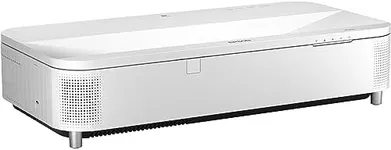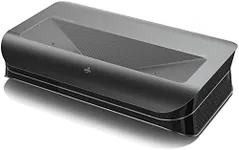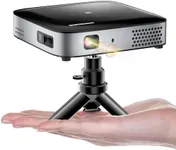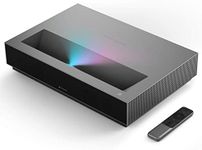Buying Guide for the Best Cheap Short Throw Projector
Choosing the right short-throw projector can significantly enhance your viewing experience, whether it's for home entertainment, business presentations, or educational purposes. Short-throw projectors are designed to project large images from a short distance, making them ideal for small spaces. To find the best fit for your needs, it's important to understand the key specifications and how they impact performance. Here are the main specs to consider and how to navigate them.Throw RatioThe throw ratio is the distance between the projector and the screen divided by the width of the image. This spec is crucial because it determines how close you can place the projector to the screen while still getting a large image. Short-throw projectors typically have a throw ratio of less than 1:1. For example, a throw ratio of 0.5:1 means you can place the projector 0.5 feet away from the screen for every foot of image width. If you have a small room, look for a lower throw ratio to maximize your screen size without needing a lot of space.
Brightness (Lumens)Brightness, measured in lumens, indicates how much light the projector can produce. This is important because it affects how well the image can be seen in different lighting conditions. For a dimly lit room, a projector with 1,500 to 2,500 lumens may suffice. For rooms with more ambient light, you might need 3,000 lumens or more. Consider where you will be using the projector and choose a brightness level that ensures a clear, vibrant image in that environment.
ResolutionResolution refers to the number of pixels that make up the image, typically expressed as width x height (e.g., 1920x1080 for Full HD). Higher resolution means more detail and sharper images. For general use, a resolution of 720p (1280x720) may be adequate, but for a more detailed and immersive experience, especially for movies or gaming, 1080p (Full HD) or even 4K (3840x2160) is preferable. Consider what you will be projecting and choose a resolution that meets your quality expectations.
Contrast RatioThe contrast ratio measures the difference between the darkest and brightest parts of an image. A higher contrast ratio means deeper blacks and more vibrant colors, which is important for image quality. A contrast ratio of at least 10,000:1 is good for most uses, but if you want the best possible picture quality, look for projectors with higher contrast ratios. Think about the type of content you will be viewing and how important image depth and color accuracy are to you.
Connectivity OptionsConnectivity options determine how you can connect your projector to other devices. Common connections include HDMI, USB, VGA, and wireless options like Wi-Fi or Bluetooth. HDMI is essential for high-definition video and audio, while USB can be useful for direct media playback. Wireless connectivity allows for easier setup and streaming from mobile devices. Consider what devices you will be connecting to your projector and ensure it has the necessary ports and wireless capabilities.
Lamp LifeLamp life indicates how long the projector's lamp will last before it needs to be replaced, usually measured in hours. This is important for maintenance and long-term costs. A lamp life of 5,000 hours or more is typical for modern projectors. If you plan to use the projector frequently, look for models with longer lamp life to reduce the need for replacements. Consider how often you will use the projector and choose a lamp life that aligns with your usage patterns.
Built-in SpeakersBuilt-in speakers can be convenient if you don't want to set up an external sound system. However, the sound quality of built-in speakers can vary. For casual use, built-in speakers might be sufficient, but for a more immersive audio experience, you might want to connect external speakers or a sound system. Think about your audio needs and whether the convenience of built-in speakers outweighs the potential benefits of better sound quality from external speakers.













![[AI Auto Focus+Auto Lens Cap]Outdoor-Projector 4K with WiFi 6 and Bluetooth:Upgrade 850 ANSI Native 1080P Jimveo Portable Projector, Auto 6D Keystone&Zoom,Home LED Movie Projector for Outdoor/Home Use](https://images-proxy.bestreviews.guide/N3B-d4ZlYJNJMfomF8c_pLE8pHI=/0x150/https://m.media-amazon.com/images/I/51PuQNz4duL._AC_CX679_.jpg)








